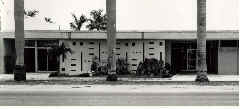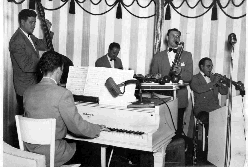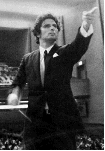85 Years in South Florida
On September 24, 1913 The American Federation of Musicians, itself only 17 years old, chartered the Musicians Protective Union, Local 655 in Miami, Florida.
In The Beginning
The biggest supporter of music in the early years was the real estate industry. In the 1920’s they were hiring big bands and using pop music to sell land in South Florida. One developer, George Merrick, even brought Paul Whiteman and his band to Coral Gables to play in the Venetian Pool (literally!). And of course Miami had always been romanticized in songs such as Joe Burke’s Moon over Miami.
.
Remember the old Local 655 building, built in 1958? It was sold in 1993 (but we’re still using the same furniture!)
The Recording Industry
In the 1960’s the recording industry was just beginning to emerge in South Florida. Criteria Recording Studio was around (it’s approaching its 40th birthday this year), but it saw mostly local demos and jingles. As late as 1966 it was still using 3-track equipment. However, in 1965 Criteria did see to the recording of James Brown’s Gold Album I Got You (I Feel Good). Other notables from the 60’s include occasional scores for the TV series Flipper and Gentle Ben being recorded at Warren Sound.
The 70’s saw the expansion of Criteria to accommodate Atlantic Records. Big names such as Count Basie, the BeeGee’s, Crosby, Stills, & Nash, and KC and the Sunshine Band were coming to sunny Florida to record their albums at places like Criteria, TK Records, and the Music Factory. Sometimes they would bring their bands, and sometimes they would use local casual musicians for their recordings. Once the disco rage started, studios sprang up everywhere.
The Casual-Club Industry
 Remember the laws in the 1940’s that prohibited music in the Hotels after 11pm? Making sure that hotel guests got a good night’s sleep ensured the emergence of the Nightclub district in Miami Beach. Those night owls that wanted to have a late meal, go dancing, and see a show with Dean Martin, Liberace, or Jerry Lewis (not to mention local acts) could go to places like the Beachcomber or the Copa Cabana. Of course, when hotels like the Fontainbleau and the Doral built special club rooms, these activities went back to the hotels. Hotel Associations had money to book bands and big acts every night and gave the nightclubs more competition than they could handle. Eventually, pressure from Latin musicians and the Condo industry, and failure to negotiate an agreement with the hotels, caused this industry to fade into the night.
Remember the laws in the 1940’s that prohibited music in the Hotels after 11pm? Making sure that hotel guests got a good night’s sleep ensured the emergence of the Nightclub district in Miami Beach. Those night owls that wanted to have a late meal, go dancing, and see a show with Dean Martin, Liberace, or Jerry Lewis (not to mention local acts) could go to places like the Beachcomber or the Copa Cabana. Of course, when hotels like the Fontainbleau and the Doral built special club rooms, these activities went back to the hotels. Hotel Associations had money to book bands and big acts every night and gave the nightclubs more competition than they could handle. Eventually, pressure from Latin musicians and the Condo industry, and failure to negotiate an agreement with the hotels, caused this industry to fade into the night.
The Symphonic Industry
The larger classical ensembles have always had a problem finding adequate performance venues. In 1926 the Miami Grand Opera gave it’s first recital in the 900,000-gallon Venetian Pool (drained, this time!). Until the War Memorial Auditorium opened in 1950 (at a cost of "only" $450,000) orchestras were playing in places like 850-seat high school auditoriums.
The 1940’s saw the rise of a number of cultural institutions. In 1944 the Opera Guild of Ft. Lauderdale was created. A year later, the Community Concert Association was formed in Broward county, bringing such groups as the New York Philharmonic and the American Ballet Theater to South Florida.
Miami Philharmonic
In 1956, after 38 years as the University of Miami Symphony, we saw the birth of the Miami Philharmonic. First led by Fabien Sevitzky and after 1967 by Alain Lombard (who recently returned to conduct Carmen for the Concert Association of Florida), it brought guest conductors such as Mitch Miller and Bruno Maderna and soloists like Van Cliburn, Andre Watts, and Frederica von Stade to South Florida. The Miami Philharmonic eventually changed its name to the Florida Philharmonic (the original owners of the name, but not connected in any way to the current FPO) and folded in 1982.
birth of the Miami Philharmonic. First led by Fabien Sevitzky and after 1967 by Alain Lombard (who recently returned to conduct Carmen for the Concert Association of Florida), it brought guest conductors such as Mitch Miller and Bruno Maderna and soloists like Van Cliburn, Andre Watts, and Frederica von Stade to South Florida. The Miami Philharmonic eventually changed its name to the Florida Philharmonic (the original owners of the name, but not connected in any way to the current FPO) and folded in 1982.
Fort Lauderdale Symphony
In 1949 a high school band director by the name of John Canfield created the Ft. Lauderdale Symphony Orchestra. There were 52 musicians that first season and tickets for the 3 concerts that season were $1 and $2 each (season tickets were $10). By the second year there were 5 concerts and 72 musicians (more than half were still nonprofessionals). The budget for the first 2 seasons amounted to a whopping $14,147. In 1963 Emerson Buckley was hired to conduct the orchestra. By 1975 the orchestra had to add a second performance of each concert set to accommodate their audiences (there was a waiting list for subscriptions!) and in 1977 they gave their first concert in the rapidly developing west Broward area (at the Sunrise Musical Theater). This was also the year that Symphony Hall (still used today for rehearsals) opened at a cost ($350,000) of almost as much as the War Memorial Auditorium.

Philharmonic Orchestra of Florida
In 1983 Paul McRae, principal trumpet with the Ft. Lauderdale Symphony, formed a chamber orchestra in Boca Raton with himself as conductor and many of the Ft. Lauderdale Symphony musicians as members. Two years later, his fledgling orchestra was merged with the Ft. Lauderdale Symphony to form the Philharmonic Orchestra of Florida (now the Florida Philharmonic).
Boca Pops
The oldest surviving ensemble in South Florida began in 1951 as the Boca Raton Municipal Band, led by Philip Azzolina. In 1970, Azzolina’s son Mark became conductor, and in 1983 they added a string section and changed their name to the Boca Raton Symphonic Pops. Their biggest period of growth came in the 1980’s; they went from 35 services a year and a budget of $140,000 in 1983 to over 120 services, almost 250,000 patrons, and a budget of almost $2 million in 1989 (the year they changed their name to Florida Symphonic Pops of Boca Raton to reflect their regional status). In 1986, they too had to add a second performance to each series to accommodate sold-out subscriptions.
The early Boca Pops was very much dance-band oriented (they were essentially a Big Band with strings). Many of the musicians were retired members of northeast coast orchestras, and they brought a great deal of show experience as well as a uniqueness and flexibility not found anywhere else. Arrangers would write with specific members of the orchestra in mind and Tony Marvin would announce the program and banter with Azzolina much the way that Ed McMahon and Johnny Carson did. Mark Azzolina had a flair for making the audience feel involved; one story tells of the audience starting to sing along during a concert and Azzolina waving the orchestra out, turning around, and conducting the audience. Guest artists during this period included Victor Borge, Marvin Hamlisch, and Henry Mancini. In 1992 Derek Stannard became conductor, the Boca Pops became the resident orchestra for the Miami City Ballet, and the orchestra, today under maestro Crafton Beck, is now the largest independent Pops orchestra in the country.
The editor wishes to thank Peter Bahler, Holly Ballard, Stuart Brenner, Sam Lane, Mike Lewis, and Mike Selker for providing pictures and for their assistance in gathering information . Thank you!Replies
Write reply
Comments must be approved before being published.






My dad was Jimmie Hayes, Vice President and a business agent of this local for many years. I grew up in that building that is shown on the website. I remember all of the great people that were there....Porter Thomas, Frank Costello and on and on. Those were the dangerous days of unions.
He was a great believer in the rights of musicians and workers. He worked tirelessly for the union and would encourage all of you to do the same thing.
I am sure that most of the current members did not know him but he was a hoot and a terrific guy.
I was looking for some local music information and found your site. Good luck to all of you.